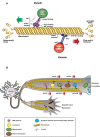Anterograde Axonal Transport in Neuronal Homeostasis and Disease
- PMID: 33071754
- PMCID: PMC7531239
- DOI: 10.3389/fnmol.2020.556175
Anterograde Axonal Transport in Neuronal Homeostasis and Disease
Abstract
Neurons are highly polarized cells with an elongated axon that extends far away from the cell body. To maintain their homeostasis, neurons rely extensively on axonal transport of membranous organelles and other molecular complexes. Axonal transport allows for spatio-temporal activation and modulation of numerous molecular cascades, thus playing a central role in the establishment of neuronal polarity, axonal growth and stabilization, and synapses formation. Anterograde and retrograde axonal transport are supported by various molecular motors, such as kinesins and dynein, and a complex microtubule network. In this review article, we will primarily discuss the molecular mechanisms underlying anterograde axonal transport and its role in neuronal development and maturation, including the establishment of functional synaptic connections. We will then provide an overview of the molecular and cellular perturbations that affect axonal transport and are often associated with axonal degeneration. Lastly, we will relate our current understanding of the role of axonal trafficking concerning anterograde trafficking of mRNA and its involvement in the maintenance of the axonal compartment and disease.
Keywords: axon growth; intracellular transport; kinesin; liquid phase separation; local translation; neurodegeneration; synaptogenesis.
Copyright © 2020 Guillaud, El-Agamy, Otsuki and Terenzio.
Figures


References
-
- Ackerley S., Grierson A. J., Banner S., Perkinton M. S., Brownlees J., Byers H. L., et al. . (2004). p38α stress-activated protein kinase phosphorylates neurofilaments and is associated with neurofilament pathology in amyotrophic lateral sclerosis. Mol. Cell. Neurosci. 26, 354–364. 10.1016/j.mcn.2004.02.009 - DOI - PubMed
-
- Ackerley S., James P. A., Kalli A., French S., Davies K. E., Talbot K. (2006). A mutation in the small heat-shock protein HSPB1 leading to distal hereditary motor neuronopathy disrupts neurofilament assembly and the axonal transport of specific cellular cargoes. Hum. Mol. Genet. 15, 347–354. 10.1093/hmg/ddi452 - DOI - PubMed
Publication types
LinkOut - more resources
Full Text Sources

